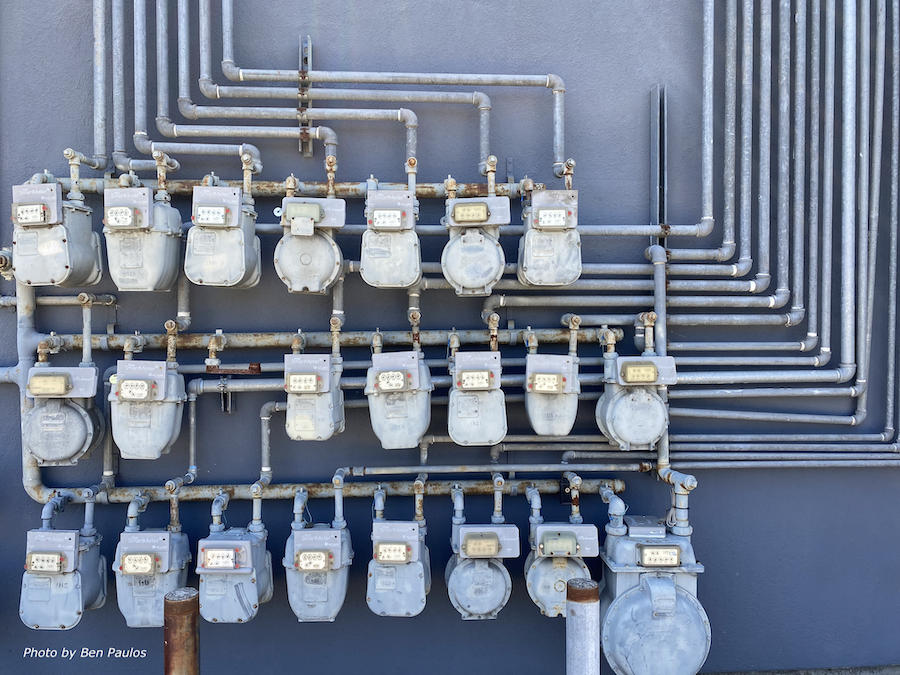New Clean Air Standards Push Out Gas Appliances
July 21, 2023
Bay Area regulators have tightened pollution standards for gas appliances, accelerating the transition to all-electric homes and businesses

Photo by Ben Paulos
While indoor air pollution from gas ovens has gotten a lot of attention from the public and press, much more pollution comes from gas-fired water heaters and furnaces. Since their smokestacks are small and dispersed on homes and buildings, their impact has been out of sight and out of mind.
But not to air regulators. The Bay Area Air Quality Management District (BAAQMD), which regulates air pollution in the nine-county region, issued new standards in March for gas-fired furnaces and water heaters. The standards, which phase in over the next eight years, will likely push gas appliances out of the market, in favor of efficient electric heat pumps.
EBCE’s Regulatory Analyst Feby Boediarto filed comments in support of the changes. The proposal “not only aligns with the State’s bold environmental direction,” she wrote, “but it also directly addresses health concerns that environmental justice communities historically have faced.”
She pointed out that communities of color are disproportionately affected by poor air quality and are at a higher risk of premature death than other populations.
Where There’s Fire, There’s Smoke
BAAQMD research found that residential gas appliances are the largest source of nitrogen oxide (NOx) emissions in the Bay Area, more than from passenger vehicles. NOx emissions cause respiratory illness and contribute to the formation of ozone, or smog.
Gas furnaces and water heaters in turn account for almost 90 percent of total residential NOx emissions. The Bay Area is currently designated a nonattainment area for particulate matter and ozone pollution.
Two-thirds of Bay Area houses and apartment buildings, or about 1.8 million housing units, rely on gas appliances for space and water heating. About 750,000 use electric heat instead, including 500,000 rental properties (about 40% of all apartment units).
Cutting those emissions would avoid up to $890 million per year in health impacts due to air pollution exposure and 85 premature deaths, according to BAAQMD.
New Standards
These numbers prompted BAAQMD to promulgate first-in-the-nation rules to regulate emissions from gas space and water heaters.
The March 15 ruling takes three steps. First, it introduces a new “ultra-low-NOx” requirement for residential central furnaces in 2024, lowering the allowable NOx emissions from 40 ng/joule to 14 ng/joule. The South Coast air regulator in Southern California and the San Joaquin Valley regulator in the Central Valley already have this standard, and technologies are widely available that can allow gas appliances to comply.
Next, a zero-NOx standard would take effect requiring customers to install electric heat pumps when old gas appliances die. Residential water heaters would make the switch starting in 2027, residential and commercial space heaters in 2029, and commercial water heaters in 2031. (The rule does not apply to current and functioning gas appliances, or to gas ovens and dryers.)
Technically, the rule never prohibits gas-fired appliances. But there are currently no zero-NOx gas appliances on the market, while electric appliances are increasingly common.
Costs and Benefits
Converting to heat pumps can be expensive, especially in older homes that may need an electric system upgrade, like a new breaker panel or new wiring.
But costs can vary widely depending on the building, local labor costs, and the type of equipment chosen.
An analysis prepared for BAAQMD by Applied Development Economics, a research firm in Lafayette, cited data from Berkeley Lab that estimated national average costs for heat pumps of about $8,000, compared to a gas furnace replacement at $5,100. The consulting firm E3 found the combined cost of a gas furnace and central air conditioner ranged from $12,000 to $24,000, while a comparable electric heat pump (which provides both heating and cooling) ranged from $7,000 to $20,000.
Data from 1,880 heat pump installations in California between December 2021 and May 2022 found an average installation cost for electric heat pumps for space heating and cooling of $17,287. Additional costs can come from upgrading the main electric panel.
A growing number of incentives are available to help cut the costs, especially for low-income households. Federal, state, and regional entities, plus cities and community choice aggregators like EBCE have programs that can help households and businesses make the transition.
Check out the incentive finder: Savings & Incentives
An analysis by the San Francisco Bay Area Planning and Urban Research Association (SPUR) found that by stacking up incentives from the federal High-Efficiency Electric Home Rebate program (HEEHR) with those from California’s TECH program and the Bay Area’s BayREN program, an income-eligible household could get over $20,000 in subsidies to go electric.
EBCE offers additional help through the Health-e Home Program, offered in partnership with BlocPower and Revalue.io. The program provides affordable financing to income-qualified customers for energy-efficient whole home upgrades including installation of clean heating, cooling, hot water systems, and electric appliances.
Local governments are also stepping up. Piedmont offers a set of incentives for heat pumps, with amounts doubled for low-income households. Berkeley is implementing a $1.5 million, two-year Just Transition Pilot to support building electrification retrofits for low-income households and identify high road workforce opportunities in the small residential sector. Albany offers a Heat Pump HVAC Rebate Program that offers incentives for heat pumps and related panel upgrades.
Still, the task of replacing gas from buildings is monumental and will take many years. The Building Electrification Institute, a think tank, estimated that electrifying all 35,432 Berkeley buildings by 2045 would cost $1.3 billion, with an additional $940 million for needed efficiency, electrical, and health and safety upgrades.
